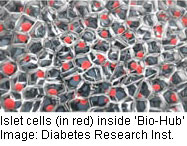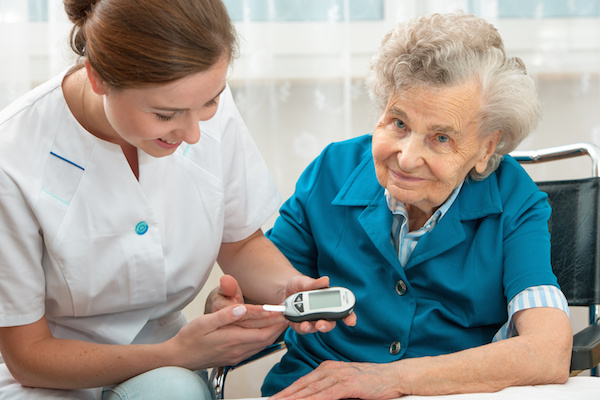
TUESDAY, March 5 (HealthDay News) — A new bioengineered, miniature organ dubbed the BioHub might one day offer people with type 1 diabetes freedom from their disease.
In its final stages, the BioHub would mimic a pancreas and act as a home for transplanted islet cells, providing them with oxygen until they could establish their own blood supply. Islet cells contain beta cells, which are the cells that produce the hormone insulin. Insulin helps the body metabolize the carbohydrates found in foods so they can be used as fuel for the body’s cells.
The BioHub also would provide suppression of the immune system that would be confined to the area around the islet cells, or it’s possible each islet cell might be encapsulated to protect it against the autoimmune attack that causes type 1 diabetes.
The first step, however, is to load islet cells into the BioHub and transplant it into an area of the abdomen known as the omentum. These trials are expected to begin within the next year or year and a half, said Dr. Luca Inverardi, deputy director of translational research at the Diabetes Research Institute at the University of Miami, where the BioHub is being developed.
Dr. Camillo Ricordi, the director of the institute, said the project is very exciting. “We’re assembling all the pieces of the puzzle to replace the pancreas,” he said.
“Initially, we have to go in stages, and clinically test the components of the BioHub,” he said. “The first step is to test the scaffold assembly that will work like a regular islet cell transplant.”
The Diabetes Research Institute already successfully treats type 1 diabetes with islet cell transplants into the liver.
In type 1 diabetes, an autoimmune disease, the body’s immune system mistakenly attacks and destroys the beta cells contained within islet cells. This means someone with type 1 diabetes can no longer produce the insulin they need to get sugar (glucose) to the body’s cells, so they must replace the lost insulin. This can be done only through multiple daily injections or with an insulin pump via a tiny tube inserted under the skin and changed every few days.
Although islet cell transplantation has been very successful in treating type 1 diabetes, the underlying autoimmune condition is still there. Because transplanted cells come from cadaver donors, people who have islet cell transplants must take immune-suppressing drugs to prevent rejection of the new cells. This puts people at risk of developing complications from the medication, and, over time, the immune system destroys the new islet cells.
Because of these issues, islet cell transplantation is generally reserved for people whose diabetes is very difficult to control or who no longer have an awareness of potentially dangerous low blood-sugar levels.
Julia Greenstein, vice president of Cure Therapies for JDRF (formerly the Juvenile Diabetes Research Institute), said the risks of islet cell transplantation currently outweigh the benefits for healthy people with type 1 diabetes.
That’s where the BioHub comes in.
“The BioHub is like a nest that the islet cells will sit in and be protected and cared for,” Inverardi said. “It’s a transparent, flat structure about the size of a quarter. It’s shaped so you can put the islet cells in it, and it’s porous to allow [the islets to develop a new blood supply].”
The device is made of a silicone compound that’s already in use for other medical conditions. “The BioHub is … like an open frame, with about 95 percent air. The design keeps the islets from clumping together,” said Ricordi, who added that this would likely translate to a need for fewer islet cells. And, he said, the design allows the researchers to add new components as they’re developed and approved.
In the future, the BioHub might be in an even more natural container, such as a tied-off vein that would create a sac to hold the islet cells, Ricordi said. The advantage of a vein is that the blood supply is already there.
Initially, the researchers will implant the BioHub in the omental pouch, an area in the lining of the abdominal cavity that connects the stomach to other abdominal organs. Once there, the BioHub would sense changing blood-sugar levels and would release insulin when needed.
Inverardi said one of the biggest advantages to the BioHub is that researchers will easily be able to find the best site to transplant islet cells, because if a site doesn’t work well, the device can be easily retrieved.
Inverardi and Ricordi both expect this phase to go well, and expect the BioHub with the transplanted islets to begin producing insulin.
Eventually, the researchers hope to develop and test immune suppression that is only in the area of the islet cells, instead of affecting the whole body. One possible way to accomplish this, Inverardi said, is to encapsulate the islet cells in a material that allows the cells to breathe and exchange insulin, but will repel any immune attack. At this point, there is no timeline scheduled for clinical trials of this portion of the BioHub.
The researchers also hope to find alternative sources for islet cells to use in the BioHub. Possible avenues of research include living, related donors; islet cells from pigs; and stem-cell-produced islets.
“We’re excited about this research,” Greenstein said. “This is an incremental step that indicates progress, but, until we get rid of the need for chronic immunosuppression, the use is limited to those with severe [low blood sugar] unawareness.”
More information
Learn more about type 1 diabetes from the Diabetes Research Institute.

